This article was first published in the Journal of the France and Colonies Philatelic Society, No. 259, March 2011. Reprinted by permission.
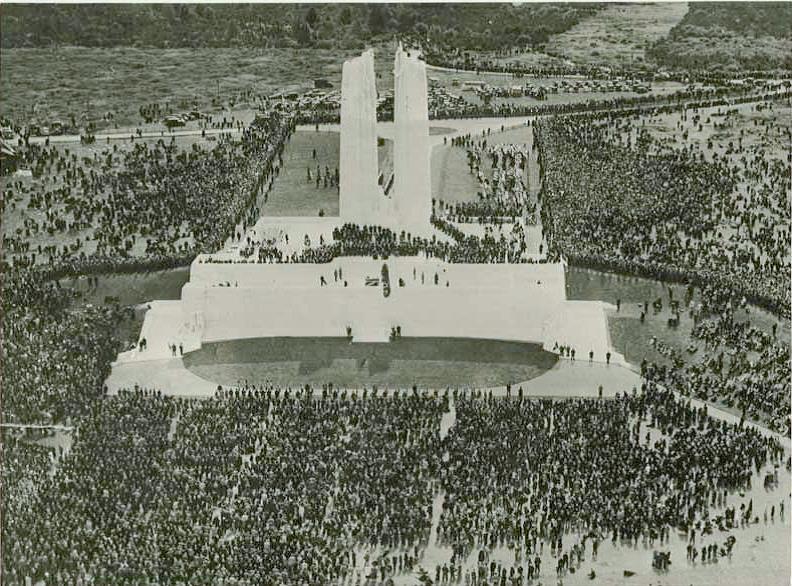
Unveiling of the Canadian Memorial on 26 July 1936
(© McMaster University Library, Hamilton, Ontario)
In 1935, in an effort to block any support for fascism in France all the parties of the left and centre combined to form the Popular Front which, at the elections of June 1936, won a sweeping victory. As a result, Léon Blum, a Marxist, became the first socialist and the first Jew to be Prime Minister of France. Despite its short life (4 June 1936 - 22 June 1937), the Popular Front government passed much important legislation, including the 40-hour week, paid holidays for the workers, collective bargaining on wage claims and the nationalisation of the arms industry.
Within weeks of the new government coming into power a noticeable change took place in the country's stamp issuing policy. Initiated by Blum's Ministre des PTT, Robert Jardillier, issues were to become more patriotic and a programme of issuing stamps related to the Great War was launched starting with two stamps commemorating the unveiling of the Canadian War Memorial on Vimy Ridge.
In the Battle of Vimy Ridge, the main combatants were the Canadian Corps against three divisions of the German Sixth Army. The battle, which took place from 9 April to 12 April 1917, was part of the opening phase of the British-led Battle of Arras, a diversionary attack for the French Nivelle Offensive. The objective of the Canadian Corps was to take control of the German-held high ground along an escarpment at the northernmost end of the Arras Offensive. The Canadian Corps captured most of the ridge on 9 April and completed their objective on 12 April 1917 when the German forces finally retreated.
The battle was the first occasion when all four divisions of the Canadian Expeditionary Force participated in a battle together, and thus became a Canadian nationalistic symbol of achievement and sacrifice. Nearly 4000 Canadians lost their lives - altogether over 66,000 Canadians died in the First World War.
In recognition of Canada's war efforts, France granted Canada perpetual use of 250 acres of land on Vimy Ridge under the understanding that the Canadians used it to establish a battlefield park and memorial. The monument architect Walter Seymour Allward was approached to create a memorial and, starting in 1921, he made 150 sketches before submitting the design which won the commission from the Canadian federal government. King Edward VIII unveiled the memorial on 26 July 1936 in the presence of French President Albert Lebrun and over 50,000 Canadian and French veterans who had made the pilgrimage. Canadian veterans were presented with a 2" diameter bronze medallion depicting the monument and the statue 'Mother Canada', one of several poignant figures on the memorial (Figure 1).
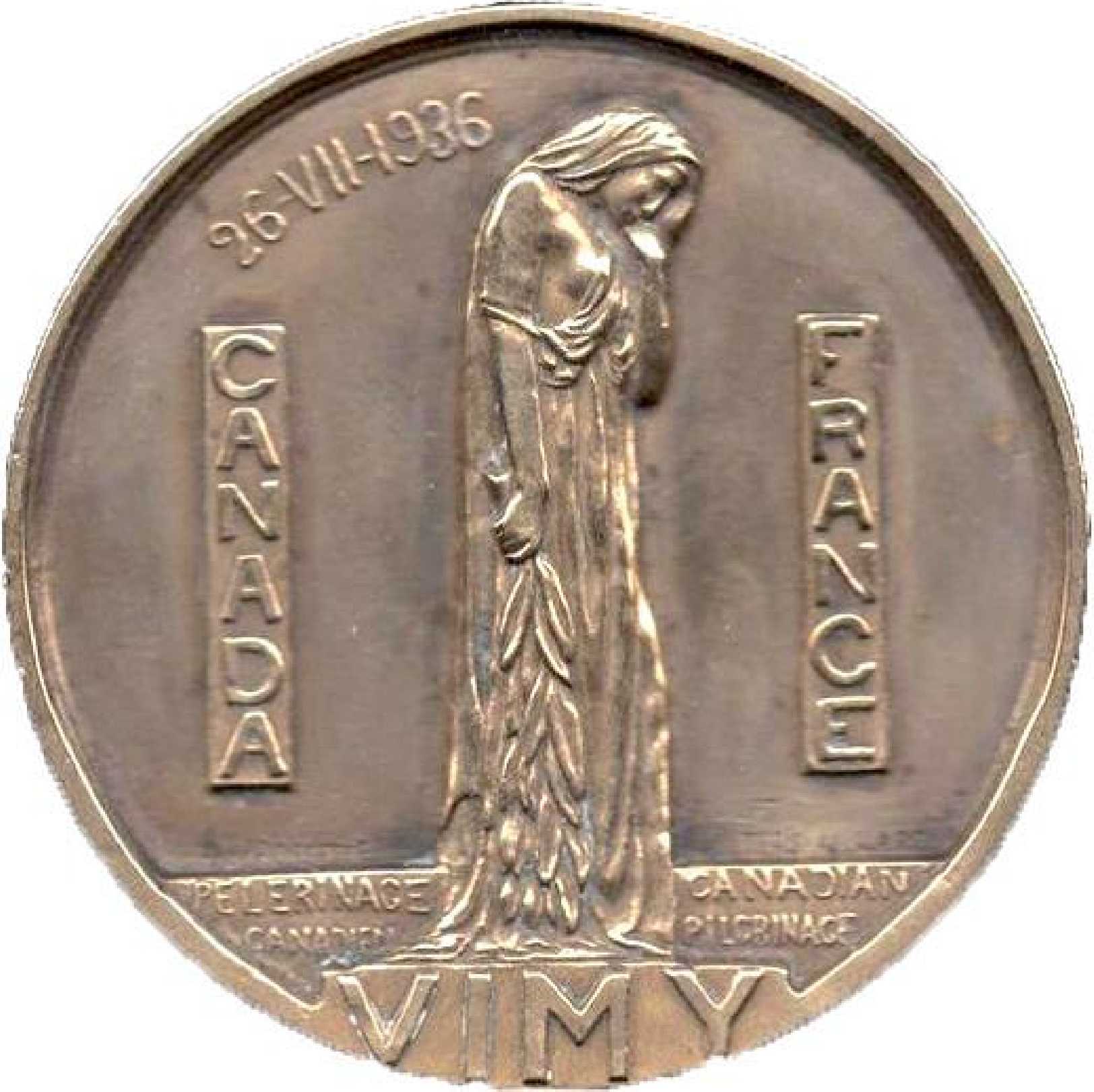
Figure 1
The pilgrims' medal, depicting 'Mother Canada'
The two stamps issued to commemorate the unveiling of the monument were designed and engraved by Henry Cheffer and depict the twin white pylons, one bearing the maple leaf for Canada the other the fleur-de-lys for France, symbolising the unity and sacrifice of both countries. The Musée de la Poste in Paris has retained in its archives the original dies engraved by Cheffer on 8 x 7 cm steel blocks (Figure 2). These are accompanied by die-proofs for each of the values signed by the Ministre des PTT, Robert Jardillier. The two values chosen were a 75c value for the concessionary Franco-Canadian Letter Rate (11 September 1929 - 31 July 1937) and a 1F50 value for the Foreign Letter Rate (1 August 1926 - 31 July 1937).
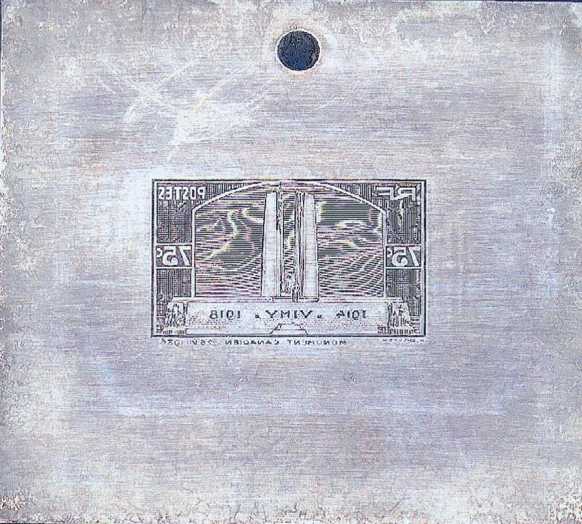
Figure 2
Original die of the 75c value
(© Musée de la Poste)
The choice of colour for the 1F50 was restricted to blue, being the regulatory UPU colour for the foreign letter rate. The only decision that had to be made was which shade of blue. The Musée de la Poste holds eight colour trials printed from a secondary die on 11 x 14 cm sheetlets each perforated with the punch control along the lower edge and with the ink number written in pencil. The colours are as follows:
| Ink Number | Shade |
|---|---|
| 5 | Blue |
| 13 | Deep greenish blue (Figure 3) |
| 1101 | Ultramarine |
| 1106 | Deep ultramarine |
| 1107 | Navy blue |
| 1108 | Turquoise |
| 1109 | Aquamarine |
| 1110 | Bright blue |
Strangely there does not exist a colour trial in the issued dark blue shade Nº 1102.
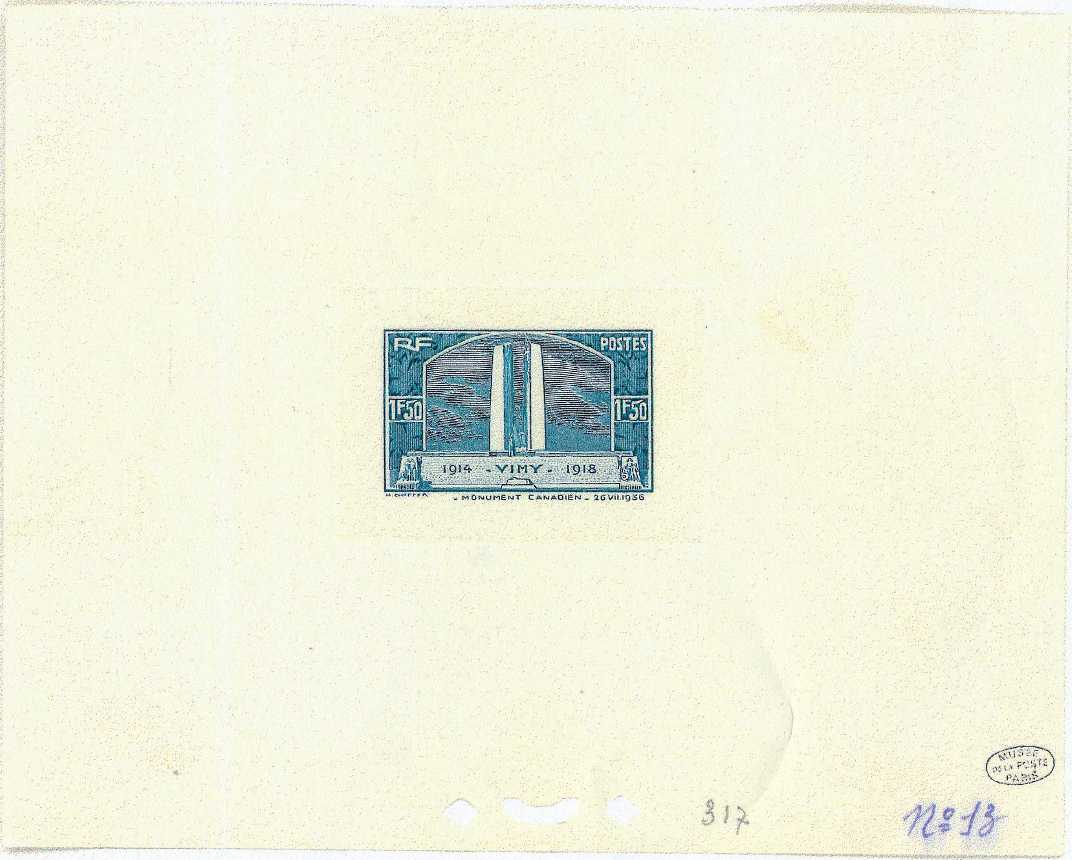
Figure 3
1F50 colour trial in ink Nº 13 deep greenish-blue
(© Musée de la Poste)
The choice of colour for the 75c value was wide open as there were no UPU colour regulations regarding this particular concessionary rate. Nine colour trials exist as follows in the same format as the 1F50.
| Ink Number | Shade |
|---|---|
| 1103 | Deep blue |
| 1108 | Turquoise |
| 1302 | Bluish green |
| 1308 | Yellow green |
| 1403 | Reddish brown [1] |
| 1505 | Blackish violet |
| 1701 | Sepia |
| 1704 | Dark grey |
| 8674 | Orange brown |
To create the bon à tirer authorising the printing of each value a colour proof was pulled from the original die in the selected colour, ie Nº 1403 for the 75c and Nº 1102 for the 1F50, and attached to a sheet of document paper. Although the bon à tirer are stamped with the cachet of the Atelier des Timbres-Poste, neither is dated or signed as is normally the case. Perhaps the die-proofs mentioned earlier that had been signed by Robert Jardillier provided sufficient authorisation for production to proceed. Presentation proofs or épreuves de luxe were issued in two formats. 25 of each value were printed on small sheets (125 x 94 mm), 70 of the 75c and 120 of the 1F50 in a larger format (156 x 126 mm). The printing figures are from the Catalogue Spécialisé Edouard Berck, 1956.
Both values were printed in sheets of 50, the 75c value from 11 to 28 July on Press 2 (Figure 4) and the 1F50 from 10 to 21 July on Press 5 and from 22 to 24 July on Press 3. 7 million and 5 million were printed respectively. The stamps were issued on the day of the unveiling, 26 July 1936, and withdrawn on 23 September. A feuille-modèle of the 75c value printed on 15 July and of the 1F50 value printed on 10 July record the details (Figure 5).
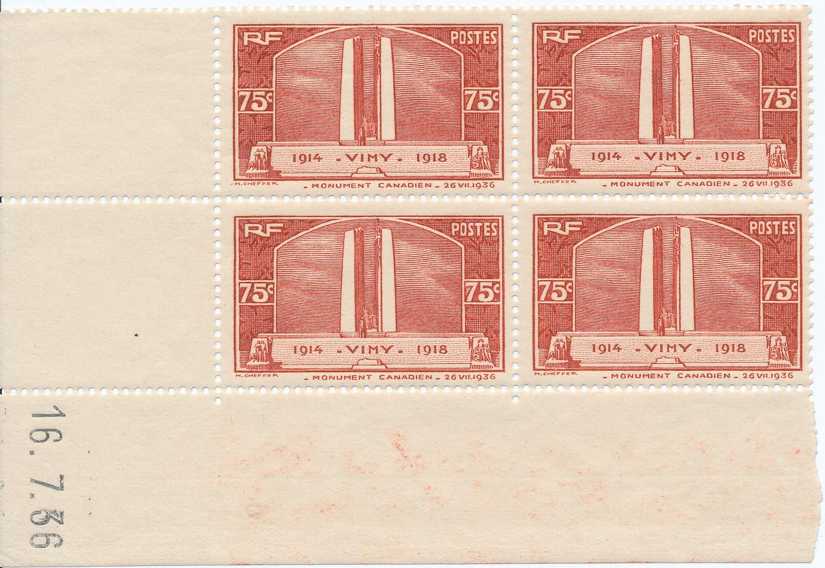
Figure 4
Dated corner block of the 75c value
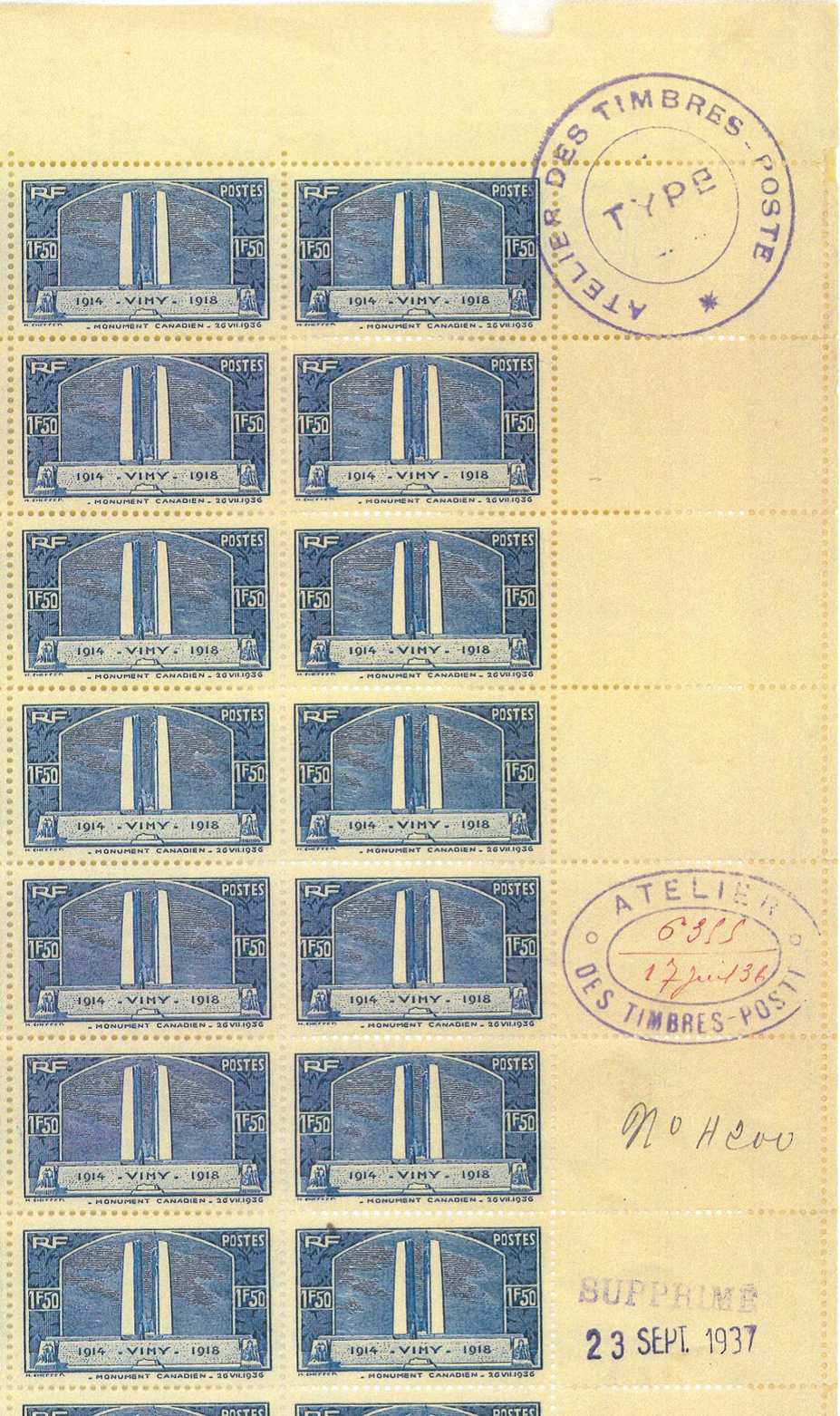
Figure 5
Part of the 1F50 feuille-modèle
(© Musée de la Poste)
To accompany the adhesives, two sets of postal stationery postcards were printed. Each set comprised 10 postcards illustrating views and details of the monument based on photos taken by the French modernist photographer Andrè Vigneau and by Fox Photos Ltd of London. The 50c set, representing the concessionary Franco-Canadian Postcard Rate (11 September 1929 - 31 July 1937), was printed with a vertical figurine in dark green depicting the statue 'Breaking of the Swords'. The horizontal figurine on the 90c set featured a view of the monument and was printed in red, being the mandatory UPU colour for the Foreign Postcard Rate (1 August 1926 - 31 July 1937). The cards were produced in photogravure by E Desfossés-Néogravure of Paris and sold at face value in a rather unimaginatively designed folding wallet (Figure 6).
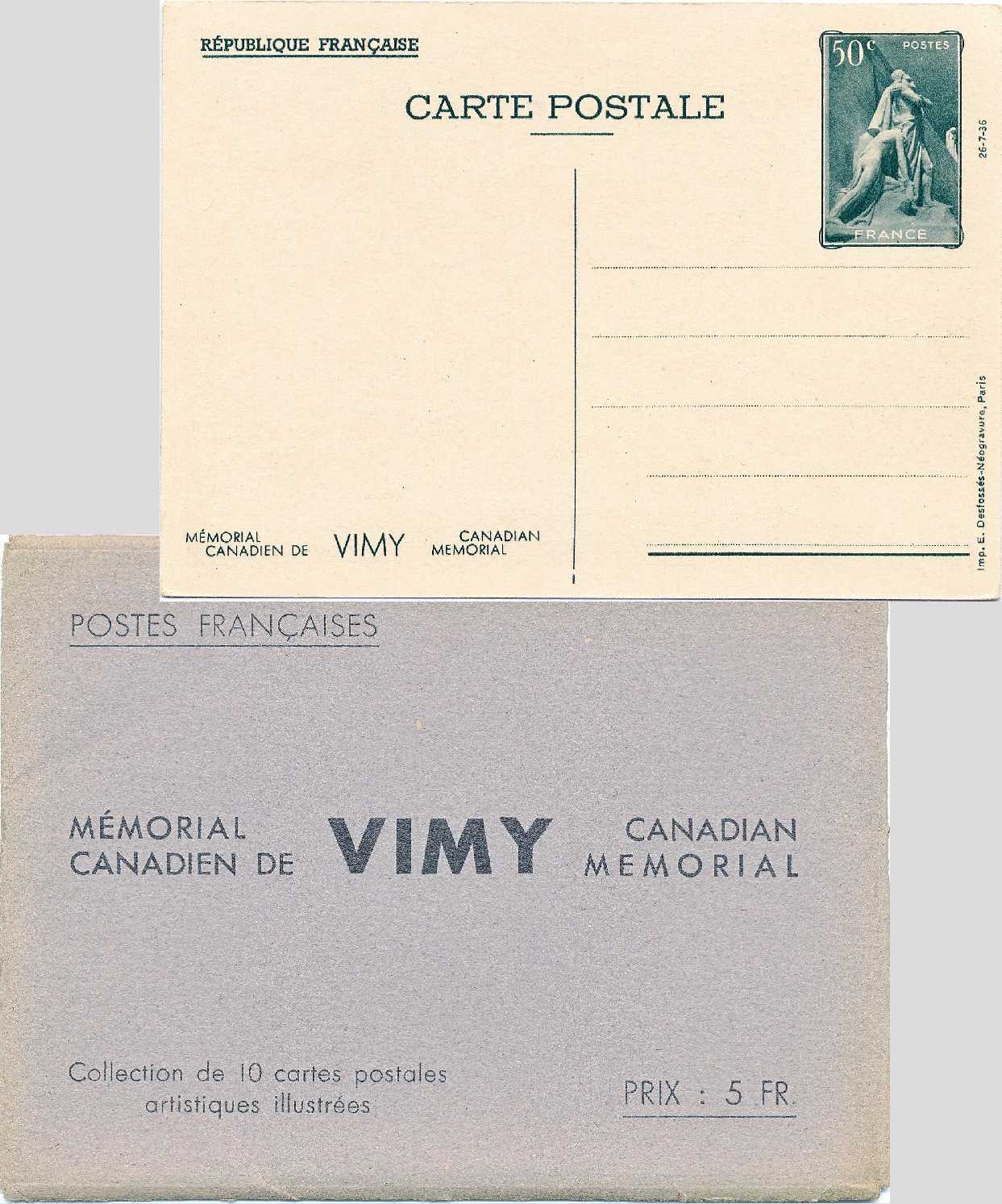
Figure 6
50c postal stationery postcard and wallet
The sale of both the stamps and the postal stationery was strictly controlled. A letter sent to all the regional and département managers by Edmond Quenot, Directeur de l'Exploitation Postale et des Services Financiers on 16 July include, inter alia, the following instructions:
"The postcards will be sold as a complete pack at 5F and 9F according to the value of the stamp.
"The sale of both stamps and postcards will take place from 25 July at the following offices: Vimy, Arras, Béthune and Lens (Pas-de-Calais), Albert (Somme) and Lille, Armentières, Douai and Cambrai (Nord) and in those localities likely to welcome war veterans participating in the event. These localities will be announced by the PTT Directors of the départements of Nord, Somme, Pas-de-Calais and possibly Aisne.
"Afterwards, the sale of the stamps will be extended to the whole country. The postcards though, in addition to the places mentioned above, will only be available to the public at the Recette Principale in Paris and in the main post offices of Versailles, Chartres, Orleans, Tours, Blois, Le Havre and Rouen.
"To enable the public elsewhere to obtain the postcards it has been decided that post offices not stocked with them can accept written requests for complete sets. The requests [...] must reach the Agence Comptable des Timbres-Poste by 1 August at the latest."
Although the letter specifies that the stamps should be available for sale from 25 July, I am not aware of any covers bearing that date. The stamps and cards appear to have been put on sale on the day of the ceremony itself, 26 July. Illustrated souvenir covers celebrating the unveiling and the pilgrimage were available and a special Krag slogan cancellation inscribed VIMY-FRANCE CANADIAN MEMORIAL - MONUMENT DE VIMY was used to cancel the mail.
Although no reference can be found in any documents it can be assumed that the cancelling was undertaken at Arras just 12 kilometres away. There may have been, however, a temporary post office on the site of the unveiling as mail can be found cancelled with a circular handstamp simply inscribed VIMY FRANCE CANADIAN MEMORIAL. (Figures 7-12).
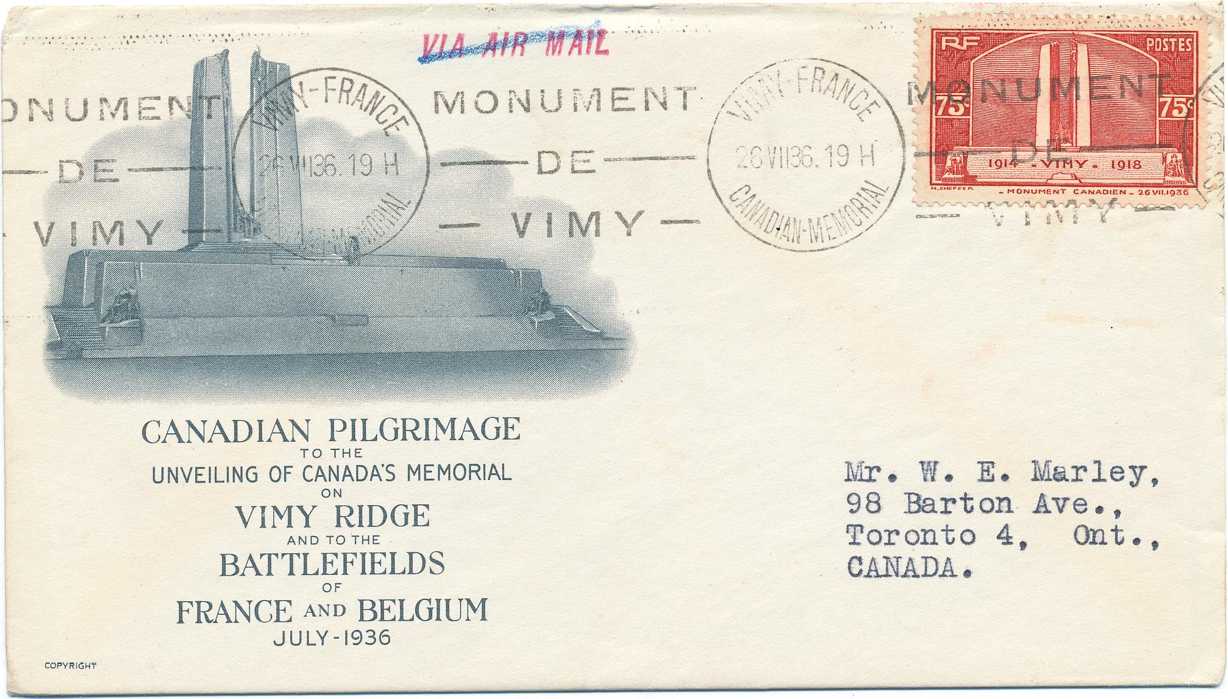
Figure 7
75c value paying the concessionary Franco-Canadian Letter Rate on First Day Cover
to Toronto, Ontario, cancelled by Krag 'Monument de Vimy'
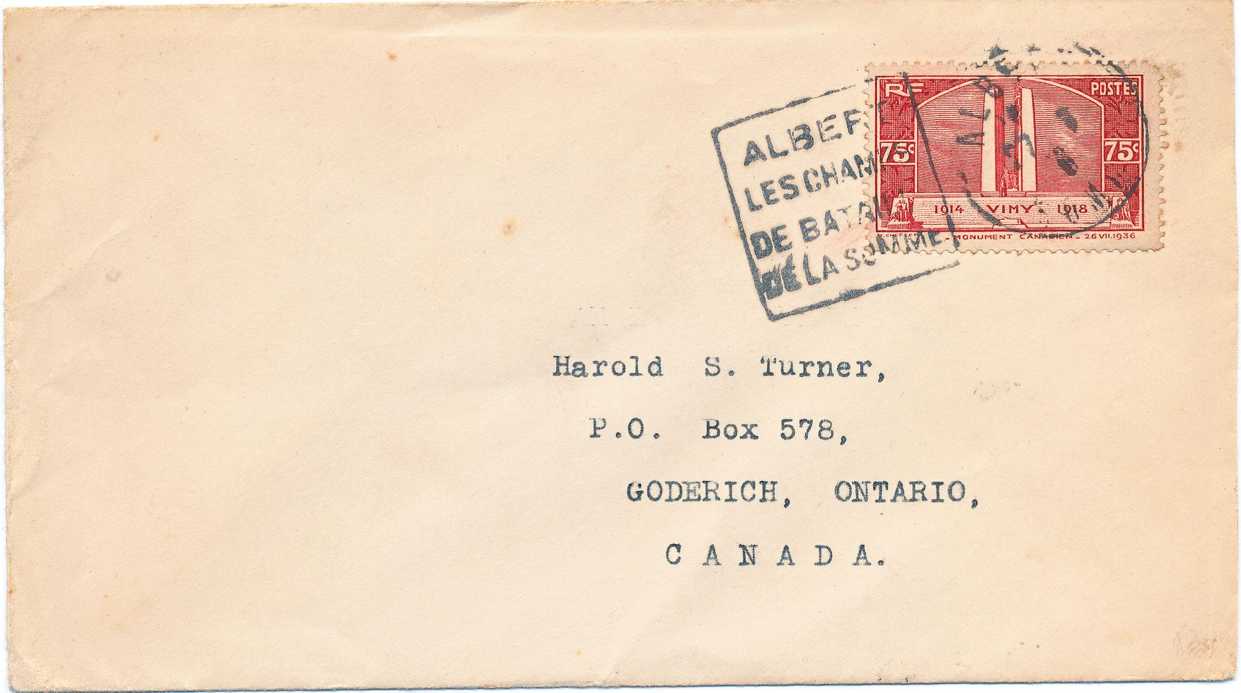
Figure 8
75c value paying the concessionary Franco-Canadian Letter Rate on cover dated
27 July 1936 to Goderich, Ontario, cancelled by Daguin 'Albert - les champs de bataille de la Somme'
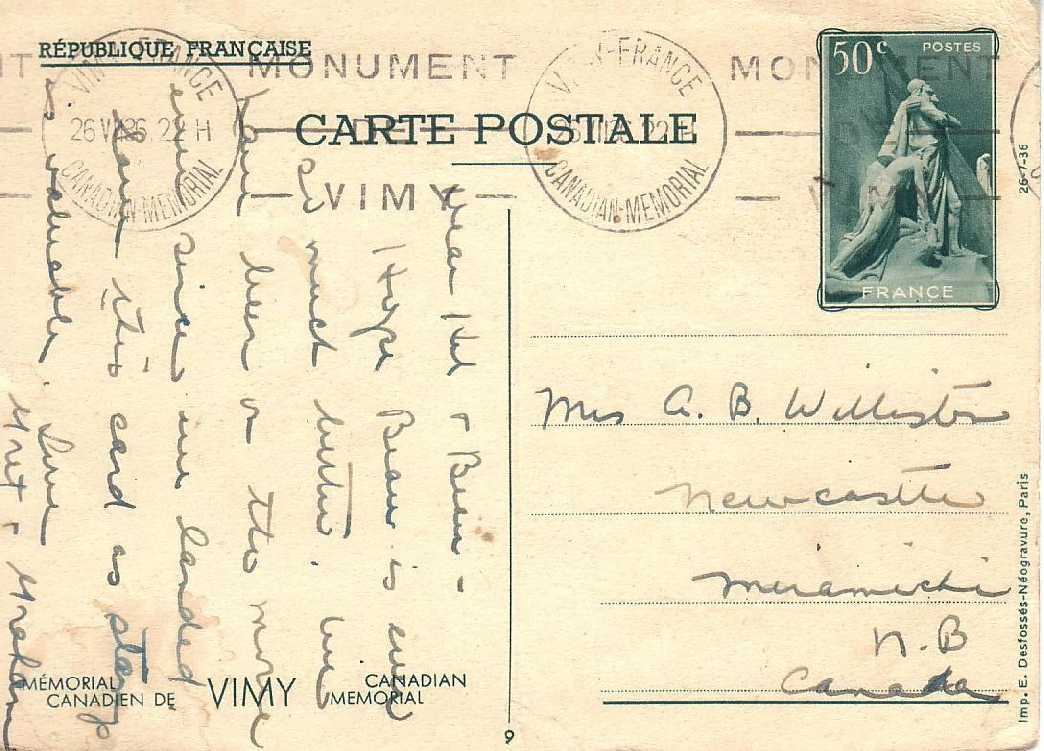
Figure 9
50c postal stationery postcard for the concessionary Franco-Canadian Postcard Rate
to Miramichi, New Brunswick, cancelled on first day of issue (© Mike Street)
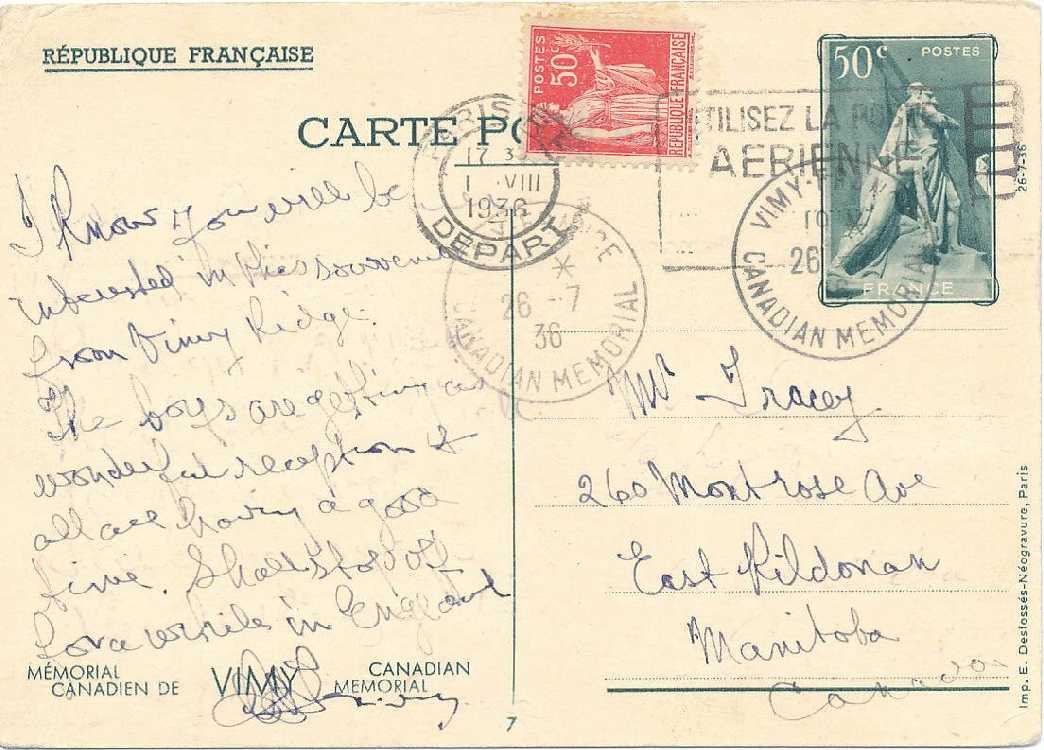
Figure 10
50c postal stationery postcard cancelled on first day of issue with Vimy-France handstamp
and sent to Paris. Original message in pencil has been erased and replaced in ink with
'I know you will be interested in this souvenir from Vimy Ridge. The boys are getting a wonderful reception .........'
The card has been franked with a 50c Type Paix to pay the concessionary
Franco-Canadian Postcard Rate and forwarded to East Kildonan, Manitoba.
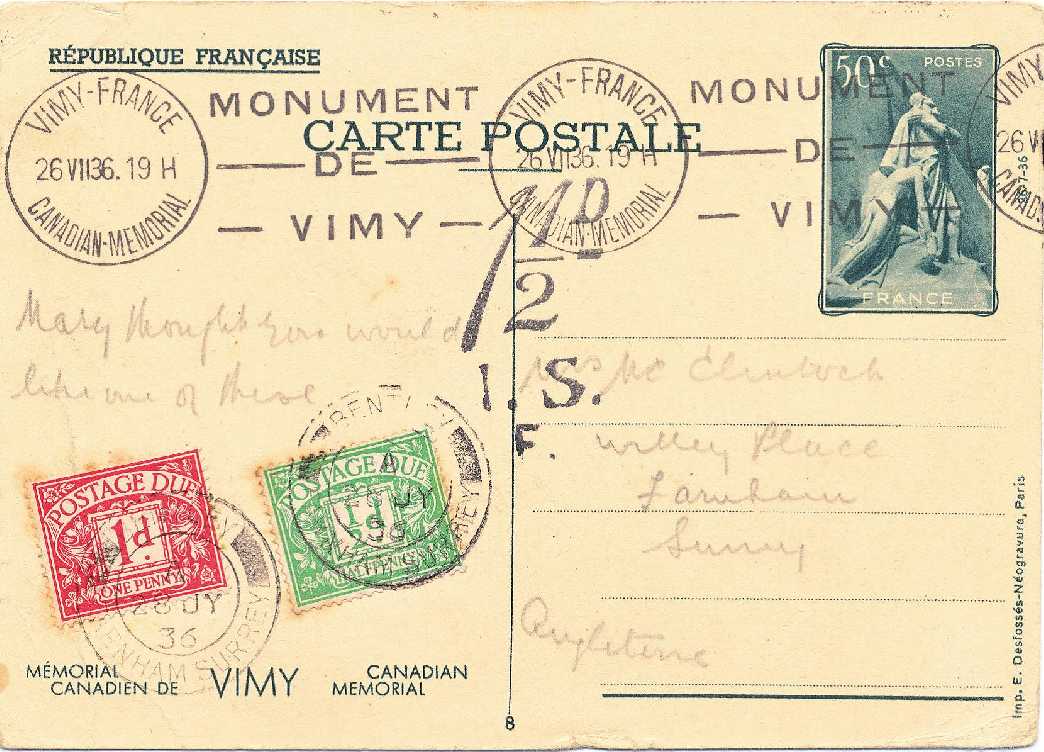
Figure 11
50c Postal Stationery Postcard to Farnham, Surrey. The card is underpaid as the
UPU Foreign Rate was 90c at the time and has therefore been taxed 1½d postage due.
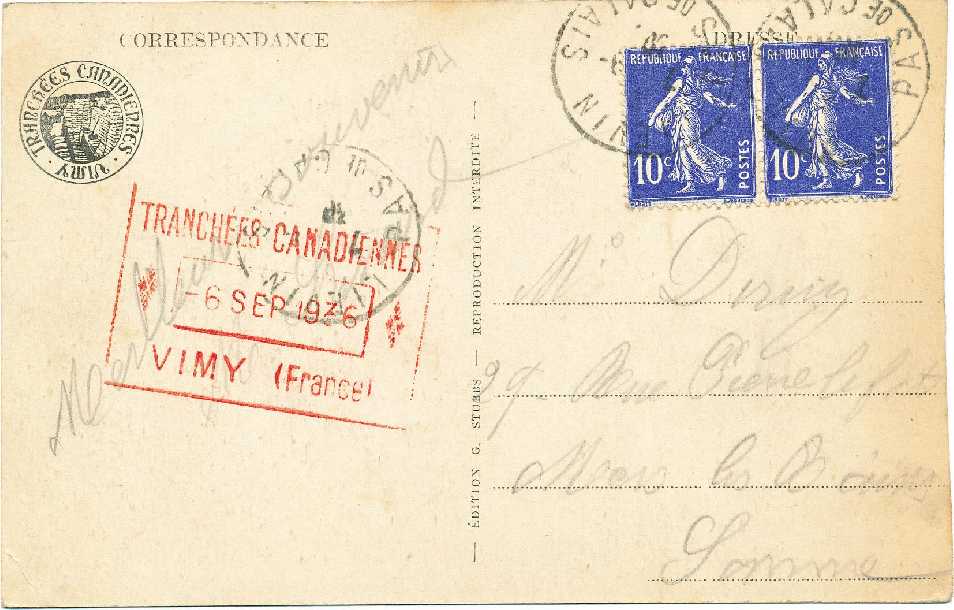
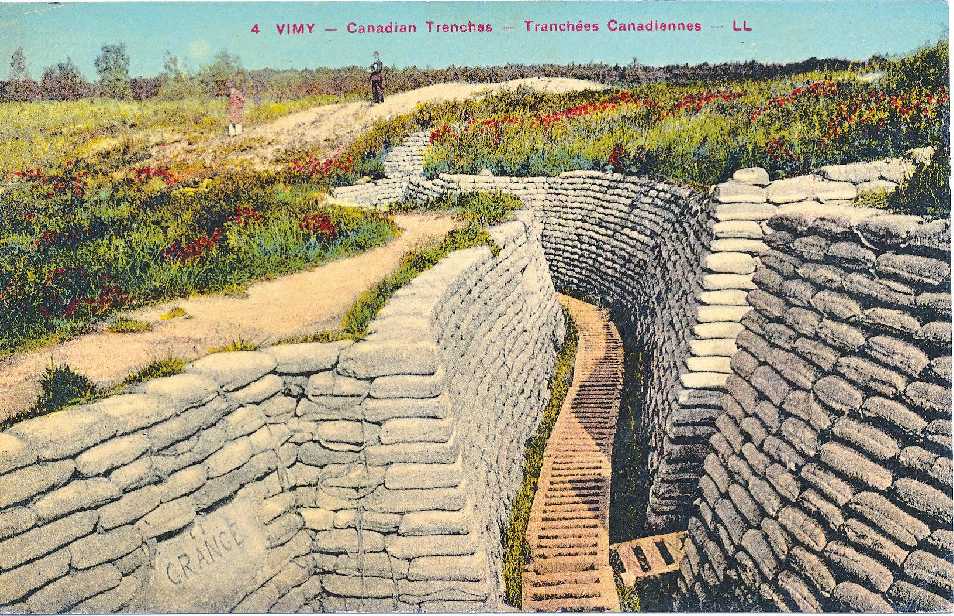
Figure 12
Picture postcard of the trenches at Vimy Ridge sent to Mers-les-Bains in the Somme.
The card has received the souvenir cachet TRANCHEÉS CANADIENNES / 6 SEPT 1936 / VIMY (France)
and was posted at Liévin in the Pas-de-Calais.
Only a few weeks after the signing of the die proofs by the Ministre des PTT, Robert Jardillier, the unveiling of the memorial, the meeting of dignitaries, the issuing of the stamps and all the attendant ceremonies were over. Robert Jardillier could look back with some satisfaction at the success of such a major event so early on in his party's new government and he could be forgiven for privately congratulating himself on the part that the PTT had played in the celebrations.
He must therefore have been delighted when he found in his in-tray a letter dated 29 July 1936 from Ian Mackenzie, the Canadian Minister of National Defence, who had attended the ceremonies (Figure 13).
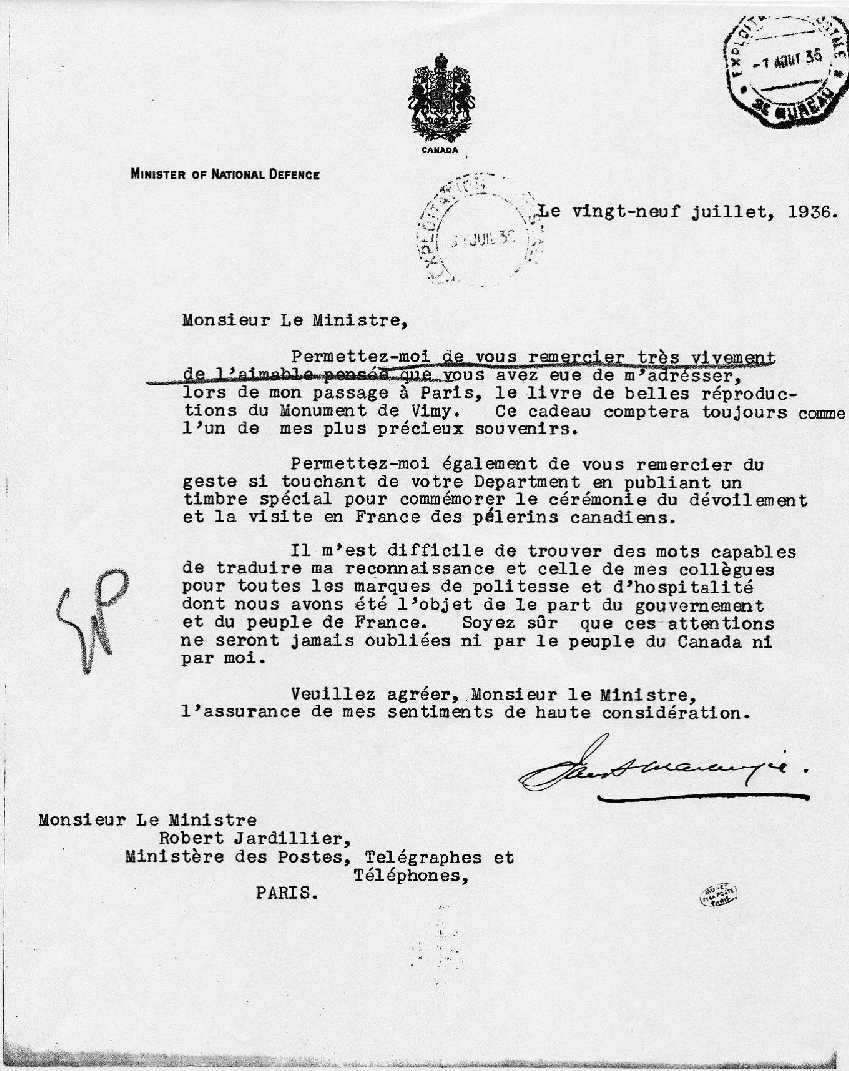
Figure 13
Letter from Ian Mackenzie to Robert Jardillier
(© Musée de la Poste)
"Dear Minister
"Please allow me to offer my heartfelt thanks for the kindness you showed to me when, upon my visit to Paris, you presented to me the book of beautiful illustrations of the Vimy Memorial. This gift will always remain one of my most precious souvenirs.
"Allow me to thank you too for the touching gesture of your Department shown in the issuing of a special stamp commemorating the unveiling ceremony and the visit of the Canadian pilgrims to France.
"It is difficult for me to find the right words to express my gratitude and that of my colleagues for all the tokens of courtesy and hospitality that we have received from the government and the people of France. Rest assured that this kindness will never be forgotten either by the people of Canada or by me.
"Yours faithfully
"Ian Mackenzie"
A job well done indeed!
Copyright © 2011 Mick Bister.
Web design copyright © 2007, 2013, 2015 The British North America Philatelic Society.
The documents on this web site are for informational and non-commercial or personal use only.
Documents on this site shall not be used on other sites or for commercial purposes without permission.
This page was last modified on 2015-02-12